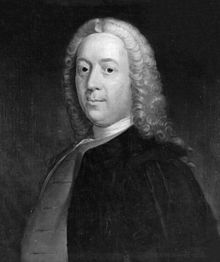Robert Simson
This article uses bare URLs, which may be threatened by link rot. (May 2021) |
This article includes a list of general references, but it remains largely unverified because it lacks sufficient corresponding inline citations. (January 2014) |


Robert Simson (14 October 1687 – 1 October 1768) was a Scottish mathematician and professor of mathematics at the University of Glasgow. The Simson line is named after him.[1]
Life[]
The eldest son of John Simson of Kirktonhall, West Kilbride in Ayrshire, Robert Simson was intended for the Church, but the bent of his mind was towards mathematics. He was educated at the University of Glasgow and graduated M.A.
When the prospect opened of his succeeding to the mathematical chair at the University of Glasgow, Simson proceeded to London for further study. After a year in London, he returned to Glasgow and, in 1711, was appointed by the university to the professorship of mathematics, an office which he retained until 1761.[2]
He was succeeded by his pupil Rev Prof James Williamson FRSE (1725-1795).[3]
Works[]

Simson's contributions to mathematical knowledge took the form of critical editions and commentaries on the works of the ancient geometers.[2] The first of his published writings is a paper in the Philosophical Transactions (1723, vol. xl. p. 330) on Euclid's Porisms.
Then followed Sectionum conicarum libri V. (Edinburgh, 1735), a second edition of which, with additions, appeared in 1750. The first three books of this treatise were translated into English and, several times, printed as The Elements of the Conic Sections. In 1749, was published Apollonii Pergaei locorum planorum libri II., a restoration of Apollonius's lost treatise, founded on the lemmas given in the seventh book of Pappus's Mathematical Collection. This work is given mention by William Paley in his Natural Theology or Evidences of the Existence and Attributes of the Deity, published in 1804, a footnote in a later edition explaining who Simson was.
In 1756, appeared, both in Latin and in English, the first edition of his Euclid's Elements. This work, which contained only the first six and the eleventh and twelfth books, and to which, in its English version, he added the Data in 1762, was for long the standard text of Euclid in England.
After Simson's death, restorations of Apollonius's treatise De section determinata and of Euclid's treatise De Porismatibus were printed for private circulation in 1776, at the expense of Earl Stanhope, in a volume with the title Roberti Simson opera quaedam reliqua. The volume contains also dissertations on Logarithms and on the Limits of Quantities and Ratios, and a few problems illustrating the ancient geometrical analysis.
Notes[]
- ^ Robert Simson. University of Glasgow (multi-tab page)
- ^ Jump up to: a b . Dictionary of National Biography. London: Smith, Elder & Co. 1885–1900.
- ^ https://www-history.mcs.st-andrews.ac.uk/Extras/Glasgow_maths.html
References[]
- This article incorporates text from a publication now in the public domain: Chisholm, Hugh, ed. (1911). "Simson, Robert". Encyclopædia Britannica (11th ed.). Cambridge University Press.
Further reading[]
- William Trail (1812) Life and Writings of Robert Simson at Google Books
- Charles Hutton (1815) Mathematical and Philosophical Dictionary, volume II, p. 395-398 (online copy, p. 395, at Google Books)
External links[]
| Wikimedia Commons has media related to Robert Simson. |
- Robert Simson, The Elements of Euclid... Errors Corrected... also The Book of Euclid's Data... Corrected 12th ed. (1804)
- Robert Simson's biography at MacTutor archive.
- Simson's line from Cut-the-Knot
- A Scottish sundial erected by Robert Simson at Kirktonhall, West Kilbride.
- The Memorial to Robert Simson in West Kilbride
- 1687 births
- 1768 deaths
- People from North Ayrshire
- Scottish mathematicians
- Alumni of the University of Glasgow
- Academics of the University of Glasgow
- 18th-century Scottish mathematicians
- 18th-century Scottish people
- Euclid